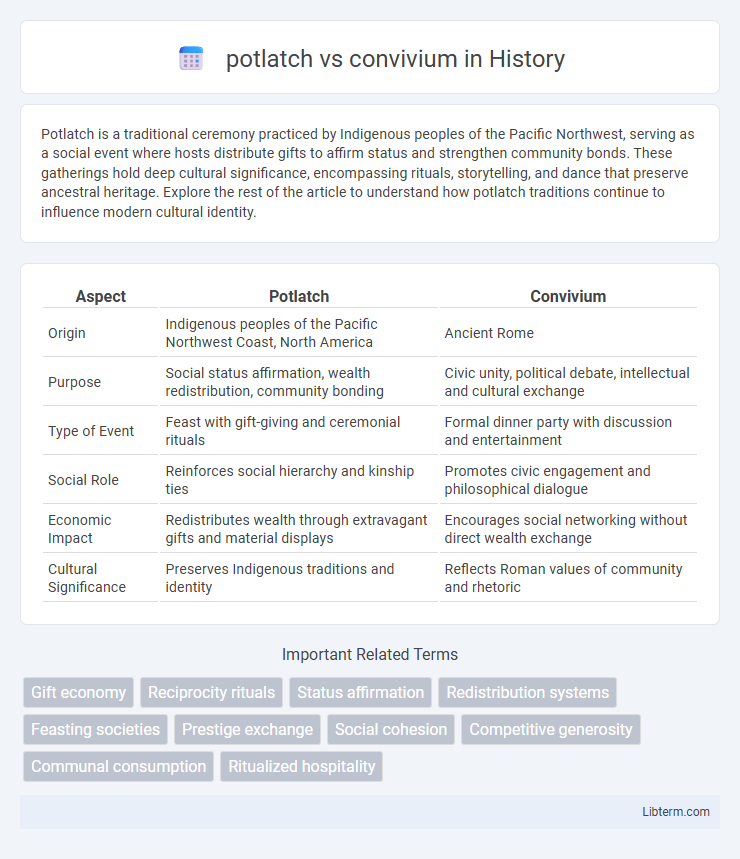Potlatch is a traditional ceremony practiced by Indigenous peoples of the Pacific Northwest, serving as a social event where hosts distribute gifts to affirm status and strengthen community bonds. These gatherings hold deep cultural significance, encompassing rituals, storytelling, and dance that preserve ancestral heritage. Explore the rest of the article to understand how potlatch traditions continue to influence modern cultural identity.
Table of Comparison
| Aspect | Potlatch | Convivium |
|---|---|---|
| Origin | Indigenous peoples of the Pacific Northwest Coast, North America | Ancient Rome |
| Purpose | Social status affirmation, wealth redistribution, community bonding | Civic unity, political debate, intellectual and cultural exchange |
| Type of Event | Feast with gift-giving and ceremonial rituals | Formal dinner party with discussion and entertainment |
| Social Role | Reinforces social hierarchy and kinship ties | Promotes civic engagement and philosophical dialogue |
| Economic Impact | Redistributes wealth through extravagant gifts and material displays | Encourages social networking without direct wealth exchange |
| Cultural Significance | Preserves Indigenous traditions and identity | Reflects Roman values of community and rhetoric |
Introduction to Potlatch and Convivium
Potlatch is a ceremonial gift-giving feast practiced by Indigenous peoples of the Pacific Northwest Coast, emphasizing social status and reciprocity through the distribution of wealth. Convivium, rooted in ancient Roman culture, refers to a formal banquet designed to foster social bonds and intellectual exchange among participants. Both traditions highlight communal gatherings but differ in cultural context and social functions.
Origins and Historical Background
Potlatch originates from Indigenous cultures of the Pacific Northwest Coast, primarily among the Kwakwaka'wakw, Tlingit, and Haida peoples, serving as a ceremonial feast for redistributing wealth and affirming social status. Convivium, rooted in ancient Roman traditions, referred to communal meals that emphasized social bonding and shared cultural values within the Roman elite. Both practices reflect distinct social and economic systems, with potlatches integral to clan identity and reciprocity, while convivium gatherings reinforced hierarchy and civic relationships in Roman society.
Cultural Contexts and Meanings
Potlatch, primarily practiced among Indigenous peoples of the Pacific Northwest, serves as a ceremonial feast that reinforces social status, redistributes wealth, and honors ancestral spirits, deeply embedded in communal reciprocity and spiritual symbolism. Convivium, originating from Roman traditions, refers to social gatherings centered on shared meals that promote political alliances, cultural expression, and intellectual exchange within elite circles. Both practices emphasize the importance of community cohesion through ritualized feasting, yet potlatch distinctly integrates spiritual duties and wealth redistribution, while convivium highlights sociopolitical networking and cultural refinement.
Social Functions in Their Societies
Potlatch serves as a ceremonial redistribution system in Indigenous Pacific Northwest cultures, reinforcing social hierarchy and community bonds through lavish gift-giving that asserts status and wealth. Convivium functions in ancient Roman and Mediterranean contexts as communal feasts that promote social cohesion, political alliances, and reciprocal relationships among participants. Both practices underscore the importance of shared resources and rituals in maintaining societal structure and fostering interpersonal obligations.
Rituals and Symbolism
Potlatch rituals, practiced by Indigenous tribes of the Pacific Northwest, involve elaborate gift-giving ceremonies symbolizing wealth distribution, social status, and community cohesion through the destruction or redistribution of goods. Convivium, rooted in ancient Roman tradition, centers on communal feasting that symbolizes social harmony, hospitality, and the reinforcement of political alliances through shared meals. Both rituals use symbolic acts--potlatch through ceremonial giving and destruction, convivium via communal dining--to express and reaffirm social bonds and power structures.
Gift-Giving Traditions
Potlatch and convivium are distinct gift-giving traditions that emphasize social status and community bonding. Potlatch, practiced by Indigenous peoples of the Pacific Northwest, involves elaborate feasts where hosts distribute wealth to guests to assert prestige and redistribute resources. Convivium, rooted in ancient Roman culture, centers on communal dining and mutual exchange of gifts that reinforce social hierarchy and strengthen alliances.
Status, Hierarchy, and Power Dynamics
Potlatches serve as elaborate ceremonial gift exchanges among Indigenous peoples of the Pacific Northwest, where hosts enhance their social status and solidify hierarchy by distributing wealth, demonstrating power through generosity and resource control. Convivium, rooted in Roman traditions, functions as a communal banquet fostering social bonds among equals, with status reflected in seating arrangements and oratory rather than material redistribution. Power dynamics in potlatch emphasize competitive prestige and wealth display, while convivium centers on collective identity and reciprocal social cohesion without overt dominance.
Economic Implications and Resource Exchange
Potlatch and convivium represent distinct economic systems centered on resource redistribution and social status reinforcement. Potlatch, practiced by Indigenous peoples of the Pacific Northwest, involves competitive gift-giving ceremonies that redistribute wealth and solidify social hierarchies, often leading to temporary resource depletion but long-term community cohesion. Convivium, rooted in Roman tradition, emphasizes reciprocal hospitality and shared meals that facilitate mutual economic support and alliance-building without large-scale wealth redistribution.
Evolution and Modern Adaptations
Potlatch, originating from Indigenous Pacific Northwest cultures, evolved from a ceremonial gift-giving event symbolizing social status and community solidarity to include modern adaptations such as cultural festivals and legal protections affirming Indigenous rights. Convivium, rooted in ancient Roman traditions of communal feasting, has transformed into contemporary social dining experiences emphasizing inclusivity, shared culinary enjoyment, and the fostering of community connections in varied cultural contexts. Both practices illustrate a dynamic evolution from ritualized gatherings to modern frameworks promoting social cohesion and cultural heritage preservation.
Comparative Analysis: Potlatch vs. Convivium
Potlatch and convivium both serve as ceremonial feasts that reinforce social bonds and status, yet potlatch is characterized by competitive gift-giving among Indigenous peoples of the Pacific Northwest, emphasizing wealth redistribution and social hierarchy. Convivium, rooted in classical Roman culture, centers on communal dining and intellectual discourse, fostering civic unity without the overt display of wealth. The contrasting emphasis highlights potlatch's ritualized economic exchange versus convivium's focus on social cohesion and shared knowledge.
potlatch Infographic

 libterm.com
libterm.com